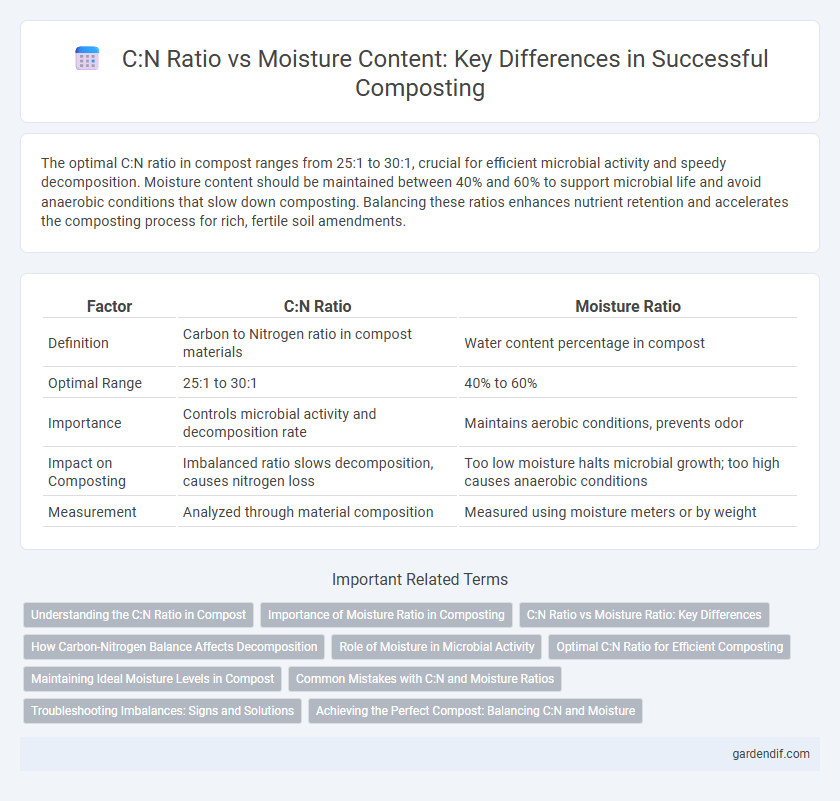
C:N Ratio vs Moisture Ratio Illustration
The optimal C:N ratio in compost ranges from 25:1 to 30:1, crucial for efficient microbial activity and speedy decomposition. Moisture content should be maintained between 40% and 60% to support microbial life and avoid anaerobic conditions that slow down composting. Balancing these ratios enhances nutrient retention and accelerates the composting process for rich, fertile soil amendments.
Table of Comparison
| Factor | C:N Ratio | Moisture Ratio |
|---|---|---|
| Definition | Carbon to Nitrogen ratio in compost materials | Water content percentage in compost |
| Optimal Range | 25:1 to 30:1 | 40% to 60% |
| Importance | Controls microbial activity and decomposition rate | Maintains aerobic conditions, prevents odor |
| Impact on Composting | Imbalanced ratio slows decomposition, causes nitrogen loss | Too low moisture halts microbial growth; too high causes anaerobic conditions |
| Measurement | Analyzed through material composition | Measured using moisture meters or by weight |
Understanding the C:N Ratio in Compost
The carbon to nitrogen (C:N) ratio in compost plays a crucial role in microbial activity and decomposition efficiency, with an optimal range typically between 25:1 and 30:1. Proper moisture levels, usually around 50-60%, are essential to maintain microbial metabolism without creating anaerobic conditions that can slow down composting. Balancing the C:N ratio with appropriate moisture ensures rapid organic matter breakdown and high-quality compost production.
Importance of Moisture Ratio in Composting
Maintaining an optimal moisture ratio between 40% and 60% is crucial for efficient composting as it supports microbial activity and accelerates organic matter breakdown. While the carbon to nitrogen (C:N) ratio governs nutrient balance, moisture directly influences microbial metabolism and oxygen availability, preventing anaerobic conditions that hinder decomposition. Proper moisture control ensures a faster, odor-free composting process, enhancing the quality of the final compost product.
C:N Ratio vs Moisture Ratio: Key Differences
The C:N ratio and moisture ratio are critical parameters influencing compost quality and microbial activity. The optimal C:N ratio typically ranges from 25:1 to 30:1, balancing carbon and nitrogen for efficient decomposition, while the ideal moisture content for composting usually lies between 40% and 60%, ensuring adequate microbial metabolism without anaerobic conditions. Understanding the key differences, the C:N ratio controls nutrient availability, whereas moisture ratio affects microbial habitat and oxygen diffusion, both essential for effective organic matter breakdown.
How Carbon-Nitrogen Balance Affects Decomposition
The carbon-to-nitrogen (C:N) ratio plays a critical role in compost decomposition by influencing microbial activity; an optimal C:N ratio between 25:1 to 30:1 ensures efficient breakdown of organic materials. Moisture content, ideally maintained between 40% to 60%, supports microbial life and facilitates nutrient exchange but excess moisture can create anaerobic conditions that slow decomposition. A balanced C:N ratio combined with proper moisture levels accelerates composting by optimizing microbial metabolism and nutrient cycling.
Role of Moisture in Microbial Activity
Moisture plays a critical role in regulating microbial activity within compost by facilitating the diffusion of nutrients and oxygen necessary for microbial metabolism. Optimal moisture levels, typically between 40-60%, ensure that microorganisms can effectively decompose organic matter without creating anaerobic conditions that impede the carbon-to-nitrogen (C:N) ratio balance. Maintaining proper moisture enhances microbial efficiency, accelerating composting processes and stabilizing nutrient availability for improved soil health.
Optimal C:N Ratio for Efficient Composting
Maintaining an optimal C:N ratio of 25:1 to 30:1 is crucial for efficient composting, as it balances carbon-rich materials like dry leaves with nitrogen-rich inputs such as food scraps, promoting microbial activity. Moisture content should be kept around 50-60%, ensuring that the compost remains damp enough to support microbial metabolism without becoming waterlogged and anaerobic. Proper management of both C:N ratio and moisture optimizes decomposition rates, minimizes odors, and produces high-quality, nutrient-rich compost.
Maintaining Ideal Moisture Levels in Compost
Maintaining ideal moisture levels in compost is crucial for optimizing microbial activity and accelerating organic matter decomposition. The ideal moisture content ranges between 40% and 60%, ensuring the carbon-to-nitrogen (C:N) ratio remains balanced and prevents anaerobic conditions that slow down composting. Proper balance of C:N ratio, typically around 25:1 to 30:1, works synergistically with moisture control to produce nutrient-rich, mature compost efficiently.
Common Mistakes with C:N and Moisture Ratios
Imbalanced C:N ratios, often exceeding 30:1 or falling below 20:1, hinder microbial activity and slow composting, while excessive moisture over 60% creates anaerobic conditions leading to foul odors. Common mistakes include neglecting to adjust green (nitrogen-rich) and brown (carbon-rich) materials properly and failing to monitor moisture levels, resulting in either overly dry or waterlogged compost piles. Correcting these errors by maintaining an optimal C:N ratio around 25-30:1 and moisture content between 40-60% optimizes microbial decomposition and accelerates compost maturation.
Troubleshooting Imbalances: Signs and Solutions
Imbalanced C:N ratios in compost often cause slow decomposition and ammonia odors, indicating excess nitrogen, while improper moisture levels lead to anaerobic conditions or drying out, hindering microbial activity. Signs such as a sour smell or slimy texture suggest too much moisture, whereas dry, crumbly compost points to insufficient water. Adjusting carbon-rich materials or adding water accordingly restores balance, optimizing microbial function and accelerating compost maturity.
Achieving the Perfect Compost: Balancing C:N and Moisture
Achieving the perfect compost requires maintaining an optimal carbon-to-nitrogen (C:N) ratio between 25:1 and 30:1, which promotes efficient microbial activity. Moisture levels should be kept around 50-60%, ensuring the compost remains damp but not waterlogged to support aerobic decomposition. Balancing C:N and moisture ratios prevents odor issues and accelerates the breakdown of organic matter into nutrient-rich humus.
C:N Ratio vs Moisture Ratio Infographic

 gardendif.com
gardendif.com